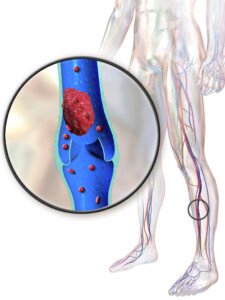
How long should DVT prophylaxis (prevention) be following hip replacement surgery to repair a fracture?
Unfortunately, there does not exist a be-all, end-all answer to this question.
Joint replacement surgeons don’t even agree on which anticoagulant drug to use.
“There is no right answer when it come to DVT prophylaxis,” says Kamala Littleton, MD, board certified orthopedic surgeon with Orthopedics and Joint Replacement at Mercy Medical Center, Baltimore, Maryland. Dr. Littleton specializes in joint, hip and knee replacement and reconstruction.
She continues, “We tend to use Coumadin for two weeks after surgery, then aspirin twice a day for an additional four weeks.
“However there are times when I just use a very low dose of Coumadin, so nothing is written in stone.
“If a patient is very high risk for PE or DVT, we will have the vascular surgeons place a temporary IVC filter.”
Hip fracture repair surgery (replacement with hardware) elicits a higher risk of deep vein thrombosis than does the elective hip replacement surgery which people have to mitigate the pain of osteoarthritis.
However, if the THR is performed with an anterior (front) entry, rather than posterior (back), this reduces the DVT risk, relative to the posterior approach.
Nevertheless, the DVT risk is still high when compared to other major surgeries, and research into the duration of the prophylaxis is intense and ongoing:
“The American College of Chest Physicians guidelines strongly recommend extending prophylaxis to up to 35 days for total hip replacement and hip fracture.” (ncbi.nlm.nih.gov/pmc/articles/PMC3195664/)
“Symptomatic VTE continues to be reported in patients within 3 months after surgery.” (ncbi.nlm.nih.gov/pubmed/21774881)
“As risk of VTE persists for up to 3 months after surgery, patients at high risk for postoperative VTE may benefit from extended prophylaxis…” (Chest. 2003 Dec;124(6 Suppl):386S-392S)
A lot of research shows that the risk of DVT following joint replacement surgery (such as hip) persists for 90 days out, even if the patient is mobile.
Nevertheless, there is no standard protocol, or universally accepted protocol, for just how long the DVT prophylaxis should be.
There’s not even a general consensus for a time range, such as four to six weeks, or seven to 10 days, or two to three months, etc.
Therefore, the proper duration of DVT prophylaxis following hip or other joint surgery is at your doctor’s discretion.
 Dr. Littleton offers years of experience and specialized training to perform anterior hip replacement as well as MAKO knee resurfacing and knee replacement. She also performs shoulder surgery.
Dr. Littleton offers years of experience and specialized training to perform anterior hip replacement as well as MAKO knee resurfacing and knee replacement. She also performs shoulder surgery.
 Lorra Garrick has been covering medical, fitness and cybersecurity topics for many years, having written thousands of articles for print magazines and websites, including as a ghostwriter. She’s also a former ACE-certified personal trainer.
Lorra Garrick has been covering medical, fitness and cybersecurity topics for many years, having written thousands of articles for print magazines and websites, including as a ghostwriter. She’s also a former ACE-certified personal trainer.
.









































